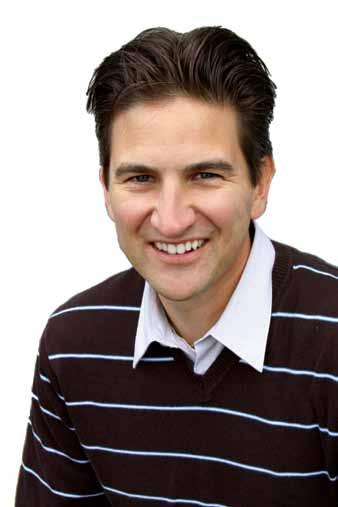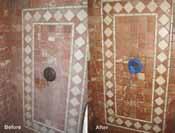


















































It seems like only yesterday that I was going door-to-door, neighborhood-by-neighborhood with a small army of Cal Poly students to hand out the first issue of SLO LIFE Magazine. Like most start-up ventures it was exhilarating, enlightening, and, quite frankly, scary as hell. This publication marks our third year in business, and I have met quite a few people along the way who have asked me some variation of the question, “Why in the world did you decide to start a magazine?” My answer usually begins with a basic recap of my resume, including my stints with both the Wall Street Journal and the New York Times .
During my years at the Times, I relished the hours I spent with the old guys in the “Decomposing Room” on the 9th floor of the aging headquarters anchoring Times Square. Since the Grey Lady was a union company they were unable (and unwilling) to fire the obsolete employees who had spent their careers meticulously doing pre-digital work, such as hand-composing newspaper stories with hot lead type. But, as computers took over, they spent their days “decomposing”—mostly by talking to impressionable newbies like me, who hung on to every word of their stories about newspaper circulation battles on the streets of Manhattan back in the day. Those are memories I would never trade, but the truth is, it was the lessons I learned working with a much less well-known media company, the Chinese Yellow Pages, which still stick with me to this day. When our paths crossed, Mark Jaffe, a former carnival barker, and Matt Davis, a dive bar tour operator, were then two very colorful thirty-something San Francisco entrepreneurs, who saw a need for an in-language Chinese version of the yellow pages in the Bay Area (despite the fact that they could not speak or write the language). They went on a wild ride and brought me and a dozen or so other souls along. And it’s those experiences that give me so much respect and appreciation for the small business people I meet locally every day as the publisher of SLO LIFE Magazine
According to Matt and Mark, the reason we all got along so well, was that I was the one and only person who had ever asked for a cash advance… before I was even an employee, during my first interview. At the time, I was truly broke. I had not lived in San Francisco long when I was down to one meal a day: two bean burritos and a glass of water at the Taco Bell on Market Street. As it turned out, my new employers could relate to my struggle because they weren’t doing much better.
Privy to the tenuous state of the business, we were all blown away when we saw Matt roll up to the office one day, not in his banged up Toyota, but in a new Rolls Royce. While scrambling at the eleventh hour to make payroll, Matt found himself lying awake the night before wondering how he was going to hold the company together. For some reason, he decided to open the classified section of the local paper where he found an ad that read, “I will give you $5,000 take over the payments on my car!” It turns out that some old rich guy had gotten himself into a bind and was unable to sell his car before leaving the country. And with serendipitous timing, the transaction gave Matt just enough cash to cover payroll. Our checks cleared, the boss had a sweet ride (which he sold at a profit two months later), and, together, we lived to fight another day.
I have a friend who likes to say, “Something is worth doing if you end up with a good story to tell after you’ve done it.” And, I see it as our mission to discover and share those stories that have been “worth doing” with you. It’s a reflection of the people living here in this incredible community that, in three years of reporting, we have not even scratched the surface.
I would like to take this opportunity to say “thank you” to everyone who had a hand in producing this issue of SLO LIFE Magazine and, most of all, to our advertisers who have made this publication, and our third birthday, possible.
Live the SLO Life!
Tom Franciskovich tom@slolifemagazine.com



Have some comments or feedback about something you’ve read here? Or, do you have something on your mind that you think everyone should know about? Let us know! To have your letter to the editor considered for publication in the “In Box” section, please email it to info@slolifemagazine.com. Be sure to include your full name and city. And, it’s best to keep it to 250 words or less.
Our advertisers get great results and we would like to tell you about it, but first we want to know about you and the objectives of your business. Call us at (805) 543-8600 to talk with our publisher, Tom, about different advertising programs—we have something for every sized budget. Or, you can log on to slolifemagazine.com/advertise and we can send you a complete media kit and loads of testimonials from happy advertisers.
4251 S. HIGUERA STREET, SUITE 800 SAN LUIS OBISPO, CA 93401
SLOLIFEMAGAZINE.COM info@slolifemagazine.com (805) 543-8600 • (805) 456-1677 fax
PUBLISHER
Tom Franciskovich
CREATIVE DIRECTOR
Sheryl Disher
Jeanette Trompeter
Paden Hughes
Chris Bersbach
Richard Fusillo

Trevor Povah
Giancarlo Campolmi
Submit your story ideas, events, recipes and announcements by visiting us online at slolifemagazine.com
Contributions chosen for publication may be edited for clarity and space limitations.
If you would like to advertise, please contact Tom Franciskovich by phone at (805) 543-8600 or by email at tom@slolifemagazine.com
So many of the stories we publish come from our readers’ great leads. We are always looking for interesting homes to profile (see “Dwelling” on page 26), have a recipe that your friends and family love? Share it with us! To get an idea, check out “Kitchen” on page 58. Is there a band we should know about? Something we should investigate? Go to slolifemagazine.com and click “Share Your Story.”
The opinions expressed within these pages do not necessarily reflect those of SLO LIFE Magazine. No part of this publication may be reproduced in whole or in part without the expressed written permission of the publisher.
Complete details regarding circulation, coverage and advertising rates, space, sizes and similar information are available to prospective advertisers. Please call or email for a media kit.
Closing date is 30 days before date of issue.
Ready to live the SLO Life all year long? It’s quick and easy! Just log on to slolifemagazine.com/subscribe. It’s just $12.95 for the year. And don’t forget to set your friends and family up with a subscription, too. It’s the gift that keeps on giving!
LETTERS TO THE EDITOR
info@slolifemagazine.com
4251 S. Higuera Street, Suite 800 San Luis Obispo, CA 93401
Letters chosen for publication may be edited for clarity and space limitations.


I would like to make a comment on the article written about Sonja Polk. I was a neighbor of hers. I never got to know her, but really enjoyed your article. I would like to add one thing about Sonja that was not mentioned in your story. She has a beautiful singing voice. As a neighbor, I liked to sit outside at night and smell the air and hear the sounds of the neighborhood. There were more than a few evenings when her voice was the best sound of the evening and gave lightness to my spirit. Thank you Sonja.
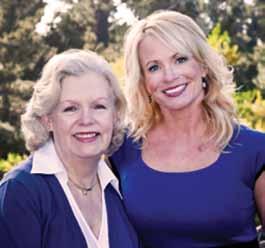 - BrendaLee Bumbalow Dominguez
- BrendaLee Bumbalow Dominguez


I read with interest your article on Teach School. I think it was sensitive, caring, and provided quite a bit of information. However, it was incomplete and included a few mistakes in regard to history.



superintendent of the district for twenty years (hence the name of the school). It was a local school, located between Ferrini Rd. and Cuesta Dr. By the late seventies, it had acquired the reputation of being the best school in SLO, that’s why I bought a house in the neighborhood. Unfortunately, my daughter was able to go there only one year, after which they closed the school and the Teach children joined the Quintana children on their campus. To make everyone more comfortable, the school was renamed Bishop’s Peak.
Meanwhile, Teach school was rented out. Some years later, it was reopened as an accelerated program, something that fit well with its environment because the school only had 16 classrooms, some of which were used as offices. Pretty soon, the district realized they were spending too much money on the Teach school students, and decided to close a school again. Everyone thought they would close Teach again, but something had happened in between: measure A. This measure was approved by voters to upgrade all the schools in the district. Instead of upgrading all the schools, district administrators decided to set aside part of the money to close Pacheco (which had 26 classrooms) and move it to Teach school. Measure A money allowed them to add 9 portable classrooms to Teach. To confuse the issue even further, they sent Charles E. Teach packing to Bishop’s Peak, and renamed Teach, Pacheco (I hope you are following me.)
Pacheco II (located where Teach school used to be): Pacheco II is a magnet school, with a bilingual English-Spanish program. It attempts to have an equal number of English-speaking and Spanish-speaking children, collects Spanish-speaking children from all over the district and brings them to the school. There are 8 buses daily, special teachers and assistants who can teach in Spanish, while others teach in English, etc. Obviously, an expensive program. It is also a failing program. Ever since its beginning around 2000, the school has been on some form of probation because too few of the Spanish-speaking children achieve proficiency in English and math. Children learn in English one week, and in Spanish the next, which means that children receive half the amount of English that they would receive in a regular school. This is a minor problem for English speaking children, who receive a great deal of help from their parents, but it is a serious one for Spanish speaking children. Between 2005 and 2011, each year less than half (sometimes as low as 23%)
There is obviously something very wrong going on, but nobody dares to bring up the issue. Any magnet school costs a great deal more than a local school (except, ironically, a school like Teach, which neither has its own campus nor its own principal). In difficult financial times, the logical thing to do is to get rid of these special programs. But pointing at a school while overlooking the other is both unfair and stupid. I have no idea why the district insists on
We would like to give a shout out to friend and advertiser Gavin Payne as he sets out on his own with his newly established real estate office here in San Luis Obispo. We wish Payne and everyone at Haven Properties much success.
Read your Blazing Trails article. I was excited to read about this, and then discovered that you a) did not say where either of the existing trails are, and b) explain where the elusive connection is. I doubt one person learned anything new except that there is a great, longer hike they can do now, but they wish they knew how to do it. A map would be helpful, inset into the photo at least. Or at least a description written up.
- Mark FlemmingPhone Message: Calling to comment on the “Blazing Trails” article: She says at no place is there an address for the location. She suggests that you give an address for future articles about
the area. She is new to San Luis Obispo and was very interested in checking it out but did not know where it was. I was happy to Google Johnson Ranch for her and give her an access point. She declined a call/email response.
- Barbara Zajac>> We got a lot of flack for this one, and rightly so. A map would have been great, but we just did not think of it at the time. For those that would like to check out the trails in great depth, we recommend that you visit Seth Smigelski’s excellent website hikespeak.com. The trails in question can be found on the site under “Johnson Ranch – Irish Hills Connector Trail in San Luis Obispo.”
Please send your comments to info@slolifemagazine.com
Follow SLO LIFE on Facebook: Visit facebook.com/slolifemagazine Visit us online at slolifemagazine.com
Letters may be edited for content and clarity. To be considered for publication your letter must include your name, city, state, phone number or email address (for authentication purposes).

Victoria finally reveals her secret: Jamestown, an Atlanta-based real estate investment company buys Court Street and Downtown Centre in SLO from Copeland Properties. The deal, which includes 195,000 square feet, was valued around $50 million. Other tenants (aside from Victoria) affected include: Pottery Barn, Urban Outfitters, the Cal Poly Store, and the space that formerly housed Sports Authority.


The lawsuit filed against the Air Pollution Control District (APCD) by Friends of Oceano Dunes and Kevin P. Rice is tossed out by Judge Charles Crandall. He found that the science and methodology used to monitor the air pollution at the dunes was solid and created by thousands of ATV enthusiasts, as was hypothesized by researchers.

In what had been called the “deepest cuts in 10 years,” the San Luis Coastal Unified School District trustees voted unanimously to trim another $4.2 million from the budget, which will include more than 40 jobs. Two full-time elementary school counselors are preserved after heavy lobbying from parents and other community members.

A group of investors who control Wild Cherry Canyon, the 2,400 acres of open space between Avila Beach and Los Osos, effectively end the $21 million effort to convert the land into a public park, which would have added some 20 miles of new coastal trails.


After 12 years of fighting about code violations, Dan De Vaul, who had spent time in jail over the dispute at one point, finally gets legal approval to operate Sunny Acres, his homeless shelter on Los Osos Valley Road. Tenants are allowed to pay for their stay by working for De Vaul gratis on the 72-acre ranch.

Al Moriarty, owner of a Grover Beach-based financial services firm, is arrested in Washington State and booked on eight separate charges including fraud and embezzlement. Moriarty, a major supporter of Cal Poly Athletics, was extradited to San Luis Obispo County jail a few days later where he turned 80-years-old while awaiting his first court appearance.


SLO City Council unanimously consents to give third year City Attorney, Christine Dietrick, a 4.7% raise bringing her salary up to $168,000. The pay hike was on top of a 3.5% increase she received in 2012. At $14,000 per month Dietrick’s income is greater than that of California State Attorney General Kamala Harris, who after a 5% pay cut in December, takes home $143,571 per year.


After ten years in business, popular Arroyo Grande ice cream parlor, Doc Burnstein’s, is moving into the space formerly occupied by Cold Stone’s Creamery on Higuera Street in SLO. In an effort to raise the $250,000 needed to open the store, owner Greg Steinberger sold stock to the community in a newly created “B-Corp.” Rumor has it that the first quarterly dividend will be paid in the form of two scoops of Peanut Butter Cup Delight on a sugar cone.

Cal Poly officials announce plans for a $200 million project to build additional on-campus housing for 1,400 students. It is reported that Residents for Quality Neighborhoods celebrated the news by throwing a backyard party, which is broken up by police after receiving a slew of anonymous calls from college students who complained that they just wanted a little peace and quiet so they could get the rest they needed to get up and go to school in the morning.
A confused, out of town black bear was found wandering around the base of Morro Rock. When questioned, he said he was just looking for “The Bears.” Authorities were puzzled for a while until one of them finally said, “Oh, you’re talking about Los Osos!” After explaining to the 250-pound bear that he was supposed to take a right on South Bay Boulevard not a left, they cautioned him to steer clear of Carlock’s Bakery where bear claws are a popular item on the menu.
Similar to Yoga Berra’s description of a particular restaurant that “always has a line, so nobody goes there,” the Tour of California saw crowds that were much smaller than expected at the Avila Beach finish line. Tejay van Garderen wins the race, but one observer points out that he could also shave valuable seconds off the time it takes him to sign his name by going with just a “T” and a “J.”

How did you start working for the Downtown Association?

I call it a happy accident. I moved here in 1974 and went to Cal Poly. I was going to study viticulture because I really wanted to learn about winemaking. I ended up opening a wine shop downtown. Then I changed my focus to journalism and went back to school. I worked for a marketing firm for a while and then the Mozart Festival. But my heart was always downtown, and so when this position became available I had a lot of the pieces and it all fit together. I’ve been here for 18 years. It’s been wonderful. It’s been a wonderful career. I’ve had a really, really good time. And I can say that downtown has really advanced in the past 15-20 years because of our efforts and our passion. All of us here in this office, we’re very passionate about downtown. So, I just kind of landed here like I was always supposed to be here.
What is the Downtown Association, really? What does it do? It has always been our M.O. to not toot our own horns or pat ourselves on our backs. I mean, a lot of people think that the City puts on the Farmers’ Market or the Concerts [in the Plaza], for example. And we often hear from people who are saying the same thing that you’re saying, “Who are you and what do you do? Are you the Chamber?” We are essentially a business improvement district. Back in 1975 a group of businesses got together and said, “We want to promote downtown more.” Back then downtown didn’t look like it does now. It was pretty different. They formed an assessment district whereby all of the businesses here, and there about 650 of them currently, assess themselves a fee. And that fee is collected by the City and dispersed back to us to do certain activities that enliven the district. It’s not a voluntary
membership. If your business falls within the boundaries it’s a mandatory fee. When you get your business tax certificate for the first time or renew it, you pay a surcharge. That makes up about a third of our budget so we have to raise other money.
What about the chain stores? Aren’t they driving out the mom and pops downtown?
I think we’re seeing a really good mix in terms of chains and independents. Our infrastructure is such that there’s not a lot of room for the bigger stores. So the smaller stores will always have the opportunities to have these little spaces like we have on Garden Street or Chorro Street or Morro Street. You are seeing some really clever entrepreneurs fill those spaces who are making them work and taking advantage of the size. Yet the bigger chain stores are also attracting foot traffic, which benefits the smaller independents. So, it’s actually a really nice mix
and I don’t really agree with people that say that the chains shouldn’t be here. I think that they provide a solid economic base, a level of sophistication and an impetus for other stores around them to maintain their properties to a certain level.
Okay, so how exactly did Farmers’ Market get its start?
In the 70’s San Luis was like the Valley on Thursday nights; it had car cruising. You remember the movie American Graffiti? It was like that. On Thursday nights the cars would go up Higuera and down Marsh and do the loop all night long. And what happened was that people stopped coming downtown on Thursdays because they didn’t want to get in the middle of all that. The town was kind of taken over by the cruisers, which sounds kind of cool but the businesses didn’t like it. So, they went to the City and said, “You need to stop the car cruising and these young hooligans.” So,
the City closed down the streets. They blocked the streets off. So, instead of cars, you had nothing. You didn’t have anybody. It was empty. Eventually, some of the restaurants got together and said, “We should do something.” They brought some barbeques out, not the big ones they have now but little ones. And then somebody said, “I know someone who has some volleyball nets.” So they set up volleyball courts on Higuera. Soon there were more activities popping up and some of the downtown businesses started setting up booths. After a while the Downtown Association stepped in and said, “Let us organize the affair.”
Who all was involved in those first Farmers’ Markets?
Hmm… let’s see… it was McLintock’s, the Wine Street Inn, which was a fondue restaurant, Wine Street Wines, which was my wine shop, Old Country Deli, and I think there was one more. I set up a booth on the street and I used to bring out beer-making supplies. I had these kits that people could buy to make their own beer. College students loved it, you know. I really enjoyed just being out there talking to people. And then I would send them down to my shop downstairs. You can’t sell alcohol at the Market. But I did have wine bottles on display and people would come over and I’d say, “I can’t serve it but I have a tasting room right downstairs.” So, I’d just funnel people right down to my shop. [laughter] For $5, or whatever it was, they could go taste wine. Farmers’ Market is just a real feel-good thing, and it has been since the beginning. I still go down there. In fact, I’ll be there tonight taking pictures. And I still get goose bumps watching people have a good time, sitting on the curb




















In 2008 local photographer, Trevor Povah, filmed and produced a documentary called “Lost in the Middle” which explored local surf culture by profiling eight Central Coast surfers. Povah explains that the surfers in our area are a different breed who are “self-reliant and understand our ocean with its fickle breaks, cold weather, and ‘sharky’ waters.” Here Povah captures his friend and fellow surfer, Anthony Circosta, in Cayucos executing a hard cutback on a perfect spring day with “just the right amount of offshore wind to help give the wave a nice shape.” Povah swam around in a wetsuit and a pair of fins for nearly two hours with his Canon 1D Mark II N, which was concealed in waterproof plastic housing to get the shot that you see here. Povah, who has since moved on from movie making, says that “video editing just destroyed my mind, and I couldn’t imagine doing that for a career.” Today, he can be found shooting landscape and architectural photos for his real estate clients while still making time to surf as often as possible. SLO LIFE
Do you have an amazing photo to share? Email it to info@slolifemagazine.com

In this installment of our “Meet Your Neighbor” series, SLO LIFE Magazine sits down for a conversation with Rick Stollmeyer. In 1998 he co-founded MindBody, a software company that provides a studio management online program to small businesses in the health and wellness industries. The company currently has 600 employees and is set to build a new campus near the San Luis Obispo Airport. MindBody is one of the Central Coast’s fastest growing companies—ever. We had a long, wide-ranging conversation that touched on everything from the wisdom of going public to instilling work ethic in young people and the psychology of small business owners. Here is his story…
So, Rick, how did all of this get started?
I had family in the area—my dad moved up to Morro Bay to retire. I was a submarine officer in the Navy when I came out in the early 90’s. We had been in a recession. I ended up in San Luis Obispo, right up the street here in the Arbors, and was working in engineering management and commuting to Vandenberg Air Force Base. I had three kids at the time. I was happy to have a job and to have moved here to the Central Coast; but, to me, what was missing in my work was a real passion for the mission. We were sending things up into orbit, like a satellite that could track terrorists, and do really important things. But, there was a lack of passion in the people I saw around there. Since I had come from submarines where—talk about passion we were truly driven by the higher-level purpose of what we were doing. And so I was hungry for an opportunity where I could really be all-in and really excited by it and with a team that was really excited. That was really the story of my career for several years. I kind of bounced around doing different things, moderately successful on the surface but not really that happy or that engaged.
One day a high school buddy of mine, Blake Beltram, gave me a call and asked me to meet him after work in Santa Barbara at a coffee shop on State Street. He said he wanted to show me something. He demonstrated an early version of the MindBody software program on his laptop. It was called “HardBody Software” at that time. He and I were talking about that meeting recently and he reminded me that I wasn’t very impressed at the time. [laughter] I wasn’t like, “Wow!” It was more like, “Okay.” I
didn’t really get excited about it until I started to spend time with the customers and could start to see the sort of impact that the software was making for them in their businesses. He had like nine clients [today MindBody has nearly 30,000] and Blake was by himself, developing the software, delivering it, training them how to use it, and taking the support calls. So my initial job was to go out and sell it. Three weeks into it I realized that Blake was getting buried by support calls. So I took the support responsibility from him and hired some Cal Poly students to start doing tech support out of my garage—and that’s how we got started.
So, you quit your secure but uninspiring job. What next?

In the early days the most natural thing for me to do was to get a laptop and just start heading up to San Francisco and down to LA and just spend time with the customers to really understand them. And the more I learned, the more I just fell in love with them. It touches everything I care about. I love small business. I love local. I love health and wellness. And, you know, something that America is just so uniquely good at, it’s the people with the dream that go chase that dream. Leave the safe job, cash in their 401k and borrow money from friends and family, take a second mortgage on their home and sign a lease on a space in a strip mall somewhere.
How has understanding the customer helped? Having that insight about who these people are gave me an understanding to know that, for example, when we went into the recession in 2008, I knew that we weren’t going to lose that many clients because they are all-in. They’re


not going to quit because their revenues went down 30%. They’re going to reduce staff, cut costs, work six, seven days a week. You’re going to go to the mattresses, man. That’s how local businesses operate. We had many competitors who didn’t understand that. We knew that. We went out and raised money and accelerated during that time. And that was a critical moment. We raised $5.6 million in March of ’09 when it was not an easy time to raise money. The markets were in turmoil and we had to do it at a discount, meaning that those investors got more equity in the company than they would have a year prior. But, those dollars were so much more valuable. The trade shows we attended were cheaper, the Google AdWords were cheaper, talent was cheaper, even the airline tickets were cheaper. So, while our competition was back on their heels waiting to see what would happen, we were accelerating. And, that was a critical moment. It’s very interesting to me that you can succeed in good times and bad. It’s all about your approach and making the right decisions. It does not necessarily mean going where the herd is going.
Whatever happened to your high school buddy? Bob Murphy, my partner now, bought him out. Blake had grown tired of the business. We weren’t making any money. I mean we were busting our butts and making nothing. Early on he said, “This really isn’t my lifelong dream.” And I said, “You know what, it might just be mine.” I was falling in love with it while he was falling out of love with it. Start-ups have these sort of strange paths like this. The clean start-up story with the perfect conception of an idea rarely is the real story. The real story is usually, how did that idea lead to the next idea and the next idea after that. So, when Bob bought him out, he embraced the notion of the online version. Blake didn’t get it. Blake, frankly was invested in the notion of the desktop software. That was his baby. He built it. And going online, as I was suggesting, was going to kill his baby.
Just to clarify, this was a critical decision in that you had opted to go with the online version and charged a small monthly fee for use of the software, which is sometimes called a subscription model instead of selling the desktop software for thousands of dollars a pop, correct? And who exactly is Bob?
Yes, that’s right, 100% online. It’s often referred to now as “cloud computing” or “SaaS,” which is software as a service. So, Bob was one of our first clients in New York. I had gone out and set up Bob in New York City. He had multiple locations of his studio called Be Yoga. He and his wife ran the studio, one of the more successful yoga studios in the country. But he
was burning out on running the studios and he ended up selling his business to YogaWorks, who was another one of our clients. So, he took a portion of the proceeds and used it to buy out Blake. So, Blake was able to get his capital out and go pursue some other things that he was interested in and now Bob’s my partner. And, when he and I started talking about where we wanted to go, we were in complete alignment. So, now I call Bob a co-founder because the company that pivoted at the time and became web-only is a very different business model, a completely different product than the one we started with. We had co-founded a new company because if we had stayed with the desktop software we wouldn’t be here today. So, it was really kind of a Phoenix rising out of the ashes of the old company.
You got the right partner and hired hundreds of happy employees. You must be a pretty decent judge of character. It took me hundreds of tries over several years to develop a method by which I could really understand someone’s value system. I can’t really describe it to you, except I ask a lot of questions about who they are and what motivates them and let them do most of the talking. Lots of open-ended questions. It isn’t that we are trying to find the flaws in people, it’s just that we are trying to find the fit. And, when you find the fit, it’s a big “Yes!” And you just go, “Wow! This person will do great here,” and it becomes a bidirectional interview where the candidate is also trying to determine whether they would flourish in this place. What are the purposes driving you? What do you want your life to be about? Are you hungry to have your work have meaning? Those people are fundamentally different than people who are the opposite of that, who may be apathetic or fatalistic, cynical perhaps with a the-world’s-going-to-hell-andthere’s-nothing-I-can-do-about-it attitude. Happy people are amazing. They just seem to be happy regardless. We look for values, not skills. It isn’t the “What” you’ve done that’s the most interesting, it’s the “Why” and what it meant to you. So, let’s say you majored in English Literature, okay. Why? And what did you get from it? The development of human ideas can be found in literature. I mean pick your author. There are so many exciting things you could say about authors and literature. So, if somebody majored in English Literature they better have some very interesting things to say about it. I’ve interviewed a lot of college grads and the ones that didn’t have to work, or the ones whose future was really scripted by their parents, you can really tell from a mile away. And when you see the ones where their parents, with all the best intentions just funnel their children a certain direction and paid for it all, they get
to the end of their college time and they are really ill-prepared to enter the workforce and they cannot explain to you why they majored in English Literature.
What advice would you give to a young entrepreneur just getting started locally? Well, first of all, avail yourself to the unique resources that we have in this community, the Center for Innovation and Entrepreneurship at Cal Poly, and the HotHouse [learn about the SLO HotHouse by turning to page 44].
That’s amazing. That’s extraordinary. I mean, how many communities have that? Second, don’t be afraid to talk about your ideas with the right people. A lot of times entrepreneurs get freaked out thinking that they’ve got to hold all their cards believing that their idea is so valuable. Ideas are cheap. Chances are a hundred people have already thought of your idea. It’s the execution of ideas that matter. We weren’t the only ones thinking of making studio management software, there were dozens of other people. We just did it better. And, so being afraid to share ideas can be detrimental because in the process of sharing them and having a conversation like we are right now— and you’ve given me some interesting things to think about today—every conversation I have, I gain something back. So, listen very carefully. And, I think you need a business partner. I don’t know any start up stories where one person did it all. I’m trying to think of one. Not Steve Jobs, not Bill Gates, not Google. So, get a partner that believes in you and is complimentary so that you’re not both trying to occupy the same space. But then you have all of the challenges of creating the relationship and there are about a hundred different ways that the relationship will fail. It’s like putting together a hit rock band, right? [laughter]
Is there a name for the burgeoning tech industry on the Central Coast? Silicon Coast? Ooh, that would be great. I like that. I like that a lot. Why don’t you start calling it that in your magazine? It’s true, we have that here. There was that company that Amazon bought; I’m having trouble remembering their name, they have 70 or 80 employees they are keeping here. Rosetta/Level is doubling down with their new building here. We’re doubling down with our new building. We’re going through city approvals right now. So, knock on wood, it’s all being approved. It will be a 60,000 square foot building located across the parking lot. It’s really going to be beautiful. The main thing is going to be the plaza. We’ll have a stage where we can have presentations and the occasional live music. We hope that playing the MindBody Plaza will become a desired ticket punch for local bands. We hope to get the permits this summer and
break ground in September and occupy it a year later, so September 2014. That will bring our total square footage up to 138,000 here in SLO because we will also be keeping our space in the buildings we are already in. That should be enough for a long time. We think that we will top out at about 800 employees in the area, right here. And, that’s probably enough for the Central Coast. I don’t know that the community needs more than that. We can also imagine satellite offices. But just looking at the roads and infrastructure there’s only so much you can do here. But this will always be our center. So, our intention here is to put our roots in deep. And this is the headquarters of the company. So, even with the satellite offices they’ll come to SLO for professional development meetings and trainings. Even though we’ll have 800 employees here, we’ll have probably another 200 to 300 employees that come here from time-to-time. They’ll stay in area hotels, eat in our local restaurants. The economic impact to the community will be huge. And I think the economic impact when we go public will be transformational. That will put us on the map. People will say, “Wow, this San Luis Obispo start-up went public? It’s headquartered in SLO right next to this great university? It’s got how many employees? This sounds like Silicon Valley thirty years ago.”
Tell us about your family. I’ve got four kids—20, 18, 13, and 8-yearsold. I’m pleased to have a happy, healthy family. My two older kids really don’t want to be a part of MindBody. My thirteenyear-old, Madison, she loves this place. I had her come during spring break to work here; she absolutely loves it. I mean real work; no screwing around. I paid her out of my pocket because I’m not sure it’s legal to hire her. But, she turns 14 soon and this summer she’s excited to work at MindBody. I think it’s cool.

It seems that industriousness runs in the Stollmeyer family…
My formative years were working at my dad’s retail store. It was so good for me. He had a lighting store in Southern California; Covina. All of my brothers and I worked there. We gained our work ethics and values from that experience. I thoroughly enjoyed that. I want my kids, if they don’t work at MindBody, and by the way, the reason my oldest doesn’t work here is that she says that people treat her differently. She felt that she wouldn’t be challenged enough. She thought she would be mollycoddled because she’s my daughter. I don’t think that’s true, but that’s how she felt. So, instead she went out and worked fast food. I mean, she got a tough job.
I said, “Why don’t you come work with me at MindBody?” And, Emily said, “Dad, I want a real job.” [laughter] That’s the kind of thing only a teenager can say to her father.
But, Emily’s college experience has to be an easier path than most other kids, right? My daughter, even though I have enough income to pay for it, and she knows it, works 20 hours a week at a dining hall at UC Santa Cruz. She was recently promoted to manager. She called me a few weeks ago and said, “Dad, I came to this realization that I was the only one working there that didn’t have to.” Her colleagues, other students, were there busting their butts at this, it’s a hard job, and they are doing it because mom and dad can’t quite afford school. But, you know what? Those kids are going to have this gift of a work ethic. They’ll have the focus and they’ll know that they’ve earned it. And my daughter, I don’t have to push her, she feels compelled to work as hard as she can. Now, she’s also working at the marine center. She started off as an unpaid docent, a volunteer, because you have to work your way in. Now they’re going to give her a paid position, so she’s not coming home this summer. I’m not one of those empty nester parents, instead I’m like, “Yeah!” I do not want a failure to launch at my house, it’s not going to happen. [laughter]
You’ve got another one graduating now, right? My son Marc has done a number of different jobs, including working at my brother’s light store, Stollmeyer Lighting. And he’s a good, hard worker. The most proud thing about my kids is that they all know how to work; they’re all self-sufficient. That’s our family’s ethic. I’m only two generations off of Dutch immigrants. Hard working people. My son is going to move down after high school to Santa Barbara—a buddy of mine runs an engineering company that he interned at last summer and did so well in computer aided design that he wants him back. Marc doesn’t want to go straight into a university, he’s had off-and-on effectiveness in a classroom setting. But, he’s been involved in robotics at Atascadero High. It’s astonishing, they have a world-class robotics team. We have this amazing robotics team that won the world championship in 2011 and is consistently in the top 5% of the 2,800 teams that are out there. They are going to St. Louis in a couple of weeks to have another shot at the world champs.
Rick, thank you for your time. It has been a pleasure talking with you. And thank you. I really enjoyed it. SLO LIFE
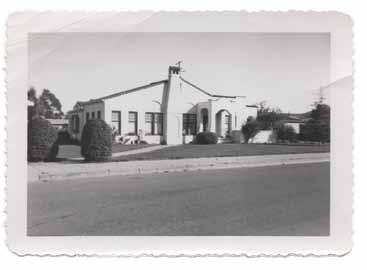
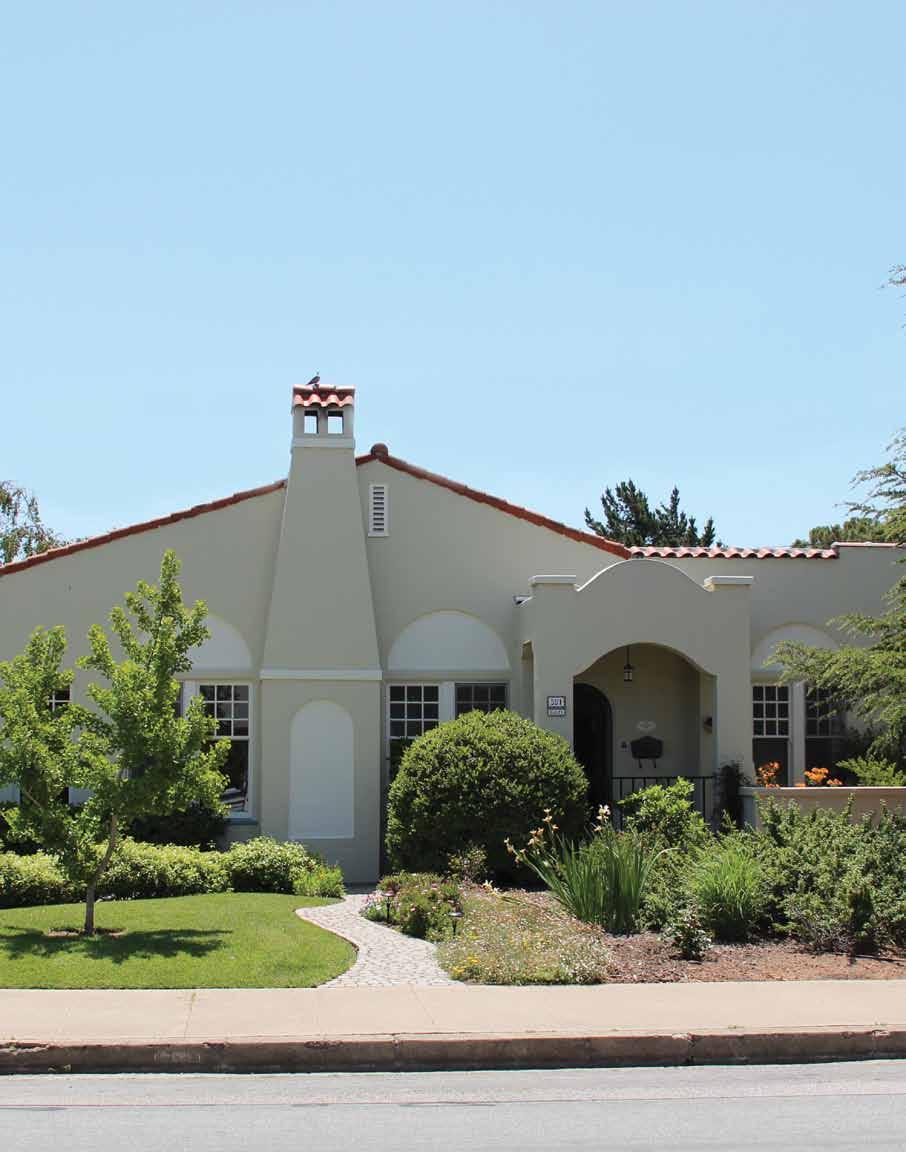
Jim Gerpheide likes to say that he does not really own his home on Islay Street, he’s just “taking care of it for a while.” And, together with his wife, Shu-chen, the couple is doing everything they can to ensure that the historic Sandercock House at 591 Islay Street will be around for generations to come.
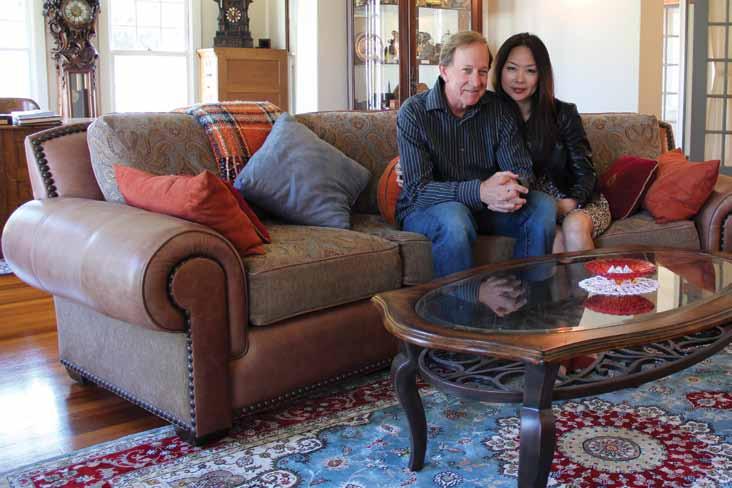
And, it does seem that Gerpheide was destined to own this home and he has certainly had serendipity on his side. Years ago, when Gerpheide was a college student at Cal Poly he rented a bedroom in a house two blocks away for $50 a month (two other roommates paid $50 each also, which amounted to $150 for the entire house). “I must have walked past this place a million times,” he remembers. Later in life, again by coincidence, he found himself settled in just a block away. That’s when he decided to write the owners of the home to inquire if they might be interested in selling. Turns out they were.
The Sandercock House is named for Norman and Fannie Sandercock who settled into the home in 1927. Warren was the son of William and Adelaide Sandercock, who founded Sandercock Transfer & Storage in 1872 (today it is the oldest known family-owned business in San Luis Obispo County). Sometime around 1905 they built a home at 535 Islay, which was just down the street from their business at Leff and Beach. During the early 1930’s, three generations of Sandercocks occupied three of the four corners of city block 58. And the families remained together in the same neighborhood for more than 20 years until Warren moved to Arroyo Grande in the 1950’s. The home then went through five different owners, each of whom owned the property for about a decade, before Grapheide mailed his letter.
And, the fact that he chose to mail a letter is just another coincidence, as the property once served as a type of letter carrier clubhouse. As the story goes, one of the previous owners was a mailman who would invite his post office friends to come by for a “cold refreshment” at the end of their shift. Apparently, a makeshift flag was hoisted on the days when the bar was open and the home would serve as a destination for postal workers to cool their feet at the end of a long day carrying the mail around town. One long-time neighbor reports that the entire corner was full of “every letter carrier in town” on some days. And, in a nod to those days, an old-fashioned street marker still points the way in the front yard garden indicating that it is “Nipomo Street” running along the side of the house.
By the time Gerpheide took ownership of the historic home, the property had seen better days. Over the years some of the basic maintenance and upkeep had been “deferred,” as they say. But, fortunately, nothing was beyond repair. And much of it just required some elbow grease, and paint. Aside from the kitchen, which underwent a complete remodel, most of the home has kept its original character. In fact, when Gerpheide first moved in, he wanted to remove the wall that had been built in over the space where the garage door had once hanged. He set out to custom design the door and a year or so later, after completing the project, a man showed up at the front door with some old black and white photos. He had inherited them from his mother and he told Gerpheide that he wanted him to have them. Upon inspecting the photos, which had the year “1953” inscribed on the back, he was shocked to see that the old garage door was exactly the same as the one as he conceived and built.
Beyond preserving and restoring the original character, the Gerpheide’s have thoughtfully placed souvenirs from their extensive travels (they have recently returned from Turkey and a beautiful handmade rug from Istanbul now rests under the coffee table in
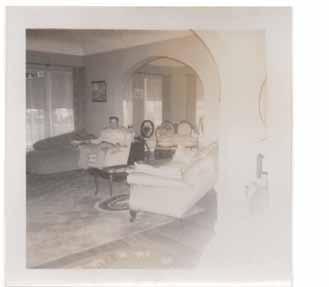
the living room). Special attention to lighting is apparent throughout, and antique fixtures can be found hanging in every room. With modern day conveniences hidden from view, it is the exquisite attention to period detail that is most impressive. Except for the kitchen and master bedroom, it would be nearly impossible to tell what year it was while wandering through the surprisingly spacious two-bedroom, two-bath home, as antiques to match the vintage of the property take you back to a time long since passed.
Outside, a backyard oasis has evolved by moving the fence further out toward the property line. A subtle Spanish styling is evident but not overdone; and hints of Shu-chen’s Asian heritage can be found by the trained eye. The couple, who met in Taiwan while Gerpheide was there on business a few years ago, points to the Formosa tree as yet another sign of serendipity. Shu-chen shares that the tree makes her “feel at home,” as Formosa is the old, informal name for Taiwan. The name originates from Portuguese explorers and translates to “beautiful island,” which could just as accurately describe the home that sits at the corner of Islay and Nipomo Streets.
The warm, buttery yellow paint, a vase bursting with rose blooms, and teal candles invite dinner guests to pull up to the antique table with its leather-backed chairs.

Vintage light fixtures and period antiques combine to transport visitors back in time.







The master bedroom features a dark wood sleigh bed, which provides contrast in the otherwise airy, light-filled room.

This Formosa tree in the courtyard is a simple, yet treasured reminder of Taiwan for Shu-chen.

Just b ig enough for two, this cozy room is the perfect place to wake up slowly with a freshly brewed cup of coffee.


Total Homes Sold Average Asking Price Average Selling Price Sales Price as a % of Asking Price Average # of Days on the Market
Total Homes Sold Average Asking Price Average Selling Price Sales Price as a % of Asking Price Average # of Days on the Market
Total Homes Sold Average Asking Price Average Selling Price Sales Price as a % of Asking Price Average # of Days on the Market
2012 17 501,965 483,117 96.74 94
2013 22 549,064 539,000 97.98 66
+/29.41% 9.38% 11.57% 1.24% -29.79%
2012 10 537,790 528,850 98.13 50
2013 9 691,644 692,933 100.17 11
+/-10.00% 28.61% 31.03% 2.04% -78.00%
2012 8 537,813 507,187 94.10 54
Total Homes Sold Average Asking Price Average Selling Price Sales Price as a % of Asking Price Average # of Days on the Market
2012 3 711,667 683,333 96.37 175
2013 14 573,571 569,785 99.64 30
+/75.00% 6.65% 12.34% 5.54% -44.44%
2013 6 832,333 820,250 98.27 105
+/100.00% 16.96% 20.04% 1.90% -40.00%
Total Homes Sold Average Asking Price Average Selling Price Sales Price as a % of Asking Price Average # of Days on the Market
2012 7 616,271 609,500 99.55 86
Total Homes Sold Average Asking Price Average Selling Price Sales Price as a % of Asking Price Average # of Days on the Market
2012 19 523,829 515,146 98.53 35
2013 17 580,485 564,794 97.62 60
+/142.86% -5.81% -7.33% -1.93% -30.23%
2013 15 603,853 593,060 98.33 58
+/-21.05% 15.28% 15.12% -0.20% 65.71%
2012 14 499,857 490,278 98.34 64
2013 12 594,317 590,468 99.48 17 johnson ave *Comparing 1/1/12 — 5/20/12 to 1/1/13 — 5/20/13
+/-14.29% 18.90% 20.44% 1.14% -73.44%
SOURCE: San Luis Obispo Association of REALTORS®










Most of us like to take the most direct route from point A to point B. That can also mean missing out on some adventures, and there are a lot of alternative routes to be explored around the Central Coast.
There’s one of those that goes from Pozo to Arroyo Grande and it’s more proof, there’s No Place Like Home.

From the sleepy little community of Pozo, there is a road less traveled, and there is kind of a reason for that. As the name implies, Hi Mountain Road takes you up and over one of the mountain ranges that separates North San Luis Obispo County from South.

In the 15-mile journey there is a lot of ground to cover. As the crow flies, it is a short cut, but you don’t want to be in a hurry when you take this drive. It is a dirt road that takes you over the rivers and through the woods that encompass this mountain pass, and there is a lot of scenery to take in along the way.
The terrain is wooded and rugged in some parts, open and airy in others. There are spots to soak up sunshine and sit a spell with
a snack or picnic lunch if so inclined.
The road is rarely this smooth, so you need to have a car with ground clearance and I would prefer 4-wheel drive, just to play it safe.
With the bumps, ruts and river crossings involved, it can sometimes be a rocky road, but there is a new view around every corner. This is a journey for those looking for a little adventure on their commute and amazing beauty along the way if they just slow down long enough to take it all in.

In the spring, Mother Nature brings a little kaleidoscope of color to the journey.
Whether you are feeling the need for an escape to Sherwood Forest, or a reminder of the wide open spaces that still exist around here, you will get a little of both on Hi Mountain Road.
Sometimes the bumpy roads are the most rewarding and it’s more proof, there’s No Place Like Home.
Jeanette Trompeter, KSBY News anchor and reporter, hosts the “No Place Like Home” series every Tuesday evening at 6pm.




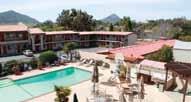



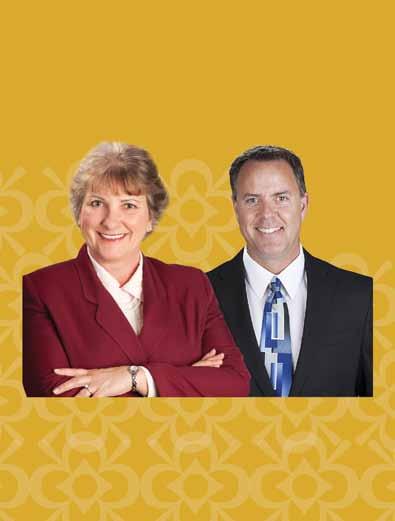

It was another gorgeous day in town when I decided to roll down all my windows and open the sunroof on my 1978 veggie oil-powered Mercedes. As I sat there at a stoplight going through downtown, I was blindsided by a plume of dust and the all-familiar sound of a gas-powered leaf blower, which had just fired up on the sidewalk to my right. I scrambled to roll up the windows, which is quite a process in my car—on a good day, one window will roll up at a time; otherwise they don’t roll up at all. On this day, the windows stayed down and the interior of my car was blanketed with whatever happened to be on the ground. Of course, I was more than a little bit annoyed, but I also felt bad for the equipment operator. It really wasn’t his fault and he gave me the “oops-sorry-about-that-bro” wave. After all he was just doing his job. But, are there other ways to do the job? Right now, as I type these words, another well-meaning gardener wielding a leaf blower is working outside my window and the noise is making me crazy. But, it has also got me thinking…
Many communities have struggled with this issue, and it appears that San Luis Obispo County may now be primed to do so, as well. After recently coming through the plastic bag debate, leaf blowers are likely next up for the Board of Supervisors, as well as the various municipalities on the Central Coast. The framework for the discussion was set back in 2010 when a Grand Jury was convened to explore the issue. Its findings were summarized in a report titled, “Leaf Blower Hazards in San Luis Obispo County,” and it is not full of good news.
After extensively researching the issue, the Grand Jury cited four primary hazards: 1) Typical two-stroke gasoline-powered leaf blowers running for one hour emit pollution equal to one car driven for 200 miles in a confined
area; 2) Approximately five pounds of particulate matter (PM) per leaf blower per hour are blown into the air and can take hours or days to settle; 3) Gas-powered leaf blowers can generate a decibel level that can cause permanent hearing loss to the operator and an annoyance to anyone nearby; 4) Young children and homebound seniors are most vulnerable to the localized air and noise pollution of leaf blowers.
The modern day leaf blower has not evolved all that much since it was invented as a crop duster in Japan during the early 1970’s. And it was during the mid-1970’s when Californians began repurposing them as an effective, watersaving alternative to hosing down driveways and sidewalks during a drought period. After observing the amazing cleanliness of their front yards, it was not long before neighbor after neighbor fell in line, often purchasing the plug-in electric version that was available in hardware stores at the time. Commercial landscapers began embracing the leaf blower after a more powerful and more mobile gas-powered version was developed.
During their early days, the electric-powered homeowner versions were mostly tolerated. The problems that did arise were often of the very local variety, as in, “My neighbor keeps blowing all of his dust and leaves into my yard!” Rarely, did municipalities have much of a debate about leaf blowers because no one really had a problem with them—besides they
made the whole town look like Main Street at Disneyland. All was fine and good, until the gas-powered variety began to explode in popularity. Back in the 1980’s, it was much more common to pay the neighborhood kid to mow your lawn and push a broom to clean up the mess afterward than it was to hire a professional. But, as commercial landscapers became more efficient, in large part because of the gas-powered leaf blower, service rates began to drop and it became a viable option for homeowners. “Mow and blow” operations are now a quintessential element of suburban living in America. And, for cities such as San Luis Obispo, where there is a high incidence of single-family dwellings that are income rental properties, twice-monthly yard maintenance service is customarily included as a matter of standard practice. It seems as if the popular radio song from the eighties, “Nobody Walks in LA,” could be re-released today with the title, “Nobody Mows their Own Lawn.”
And, it is the commercial two-stroke gas-powered leaf blower that has fallen into the crosshairs of the Grand Jury report. Two-stroke, or twocycle engines, are different than the four-stoke engine in your car in several important ways. Without going into too much detail, the two-stroke variety fires on every revolution, giving it a much better power to weight ratio, which is why you see two-stroke motors in places where being lightweight is also important: ATV’s, mopeds, jet skis, lawn mowers, and, of course, leaf blowers. The main disadvantage of the two-stroke motor is that they are highly polluting—it is not as effective at converting all the fuel to energy as its four-stroke cousin before emitting the remnants from the cylinder as exhaust. And, two-strokes are much louder and create a distinctive highdecibel whine.
Although there are four-stoke leaf blowers on the market, most of those still in use are of the two-stroke variety. It is clear that manufacturers are on the four-stroke bandwagon, mostly for reasons of fuel-efficiency, and it will probably just become a matter of time before they are the standard. But, there is still the matter of noise. A typical two-stroke leaf blower averages a decibel level of approximately 70-75dB from 50 feet away; a typical four-stroke measures in at 65dB. Under current San Luis Obispo County law, noise from leaf blowers is not to exceed 70dB. And, the City of San Luis Obispo takes it a step further by prohibiting their use on Sundays. Currently, neither the City nor the County actively enforces the noise ordinance.
So, why not just go back to the old electric models? Or, switch to the newer battery operated units? The bottom line is that they are just not powerful enough for commercial use. For example, a top-of-the-line leaf blower can generate blasts up to 280mph, which compares to a Category 5 hurricane at 160mph. Plus, electric blowers limit mobility and length of use. Regardless of power or portability, the elephant in the room still remains: artificially blowing dust into the air is not doing any of us any good, if for no other reason than the increase in the number of allergens floating around. But, it goes much deeper than that, as much of the PM composition of the dust
blasted into the ether is of the fine particulate variety, 10 micrometers or less—that kind of stuff does not normally exist in nature and, therefore, makes its way past the body’s defenses and goes directly into the lungs causing an entire host of both short and long-term health issues.
Does that mean it’s time to ban leaf blowers altogether and go back to hiring the neighborhood kid? Maybe. More than 300 cities nationwide have restricted or outright banned leaf blowers, including 100 in California. And many have developed smart policy around their use. Carmel, another popular tourist-destination-by-the-sea, became the first municipality in the nation to institute a wholesale ban on all leaf blowers, gas or electric. And, to the south, voters in Santa Barbara opted to ban leaf blowers (they still do allow electric leaf blowers, but they cannot be used within 250 feet of a residential zone). Even further south, Los Angeles, the city where nobody walks is also the city, since 1998, where nobody uses a leaf blower. A close look at the City of Claremont, which implemented a complete ban of all leaf blowers in 1990, reveals that the transition was not as difficult as expected. It was calculated that its maintenance workload on city properties increased by just 6% with the use of rakes and brooms instead of leaf blowers. Other cities have reported similar results and, although many of their local landscapers have had to raise their service rates as a result, no municipality has reversed their bans.
It would seem then that San Luis Obispo County, a place that hosts millions of tourists each year would be prime to implement a ban on leaf blowers. Yet, since the Grand Jury report in 2010, not much has changed. And, what about the county seat, the City of San Luis Obispo—the city that was the first in the nation to tackle smoking in public, prohibit fast food drive-thrus, focus on “neighborhood wellness,” and take pride in all manner of its open space and environmentally-friendly initiatives—will it continue to allow leaf blowers to exist within the city limits? As always, it comes down to a combination of political will and timing, which makes the current special election to fill the City Council seat vacated by Andrew Carter that much more intriguing [find out how the candidates would vote on this issue and more by turning to the Voters’ Guide on page 40].
To be sure, the timing has changed. Particularly in a year such as this where rain has been so scarce. The make up of matter blown into the air is more dust than leaves. And, with less rain to clean out the air above us, smoggy skies have become much more apparent. Allergy sufferers, who are legion in this area, report that leaf blowers do not help matters. Or, maybe people are just tired of seeing their neighbor’s gardener blowing leaves into their yard only to have their gardener blow them back a couple of days later. Perhaps we have a lot more knowledge now and better understand the damage we are doing to our environment and ourselves. Perhaps Central Coast residents have finally had enough of the many backpack-style engines competing to see who can make the most noise and want to restore peace and quiet. Or, maybe they just want to see the neighborhood kid push a broom again. SLO LIFE
Why are you running for City Council?
I was asked to run by resigning Councilman Andrew Carter, former Mayor Dave Romero and other community leaders. We need a broad spectrum of voices on council to maintain balance and common sense decision making.
I am running for city council because I love San Luis Obispo and I believe in giving back to my community. I will work to protect our beautiful environment while promoting economic vitality.
With SLO choosing a new City Council member, it is time to get to know the candidates...



In your view, what is the biggest issue facing SLO today? What is your position on the proposed homeless shelter on South Higuera?
Keeping SLO economically vibrant, while retaining the charm we are celebrated for. Through good planning, we can provide for necessary workforce housing and commercial uses without spreading out to the LOVR and Edna Valley corridors.
The site is too small to adequately accommodate a 200 bed shelter and will negatively impact the surounding neighborhoods. We need to mitigate these issues and secure more funding before moving the proposed shelter forward.
Would you support a ban on leaf blowers?
No, this would be challenging to enforce. In areas of town this is a great concern, in others, not as much. I’d rather see home owners associations and neighborhood groups build consensus on the issue.
Housing and fiscal stability are ongoing issues, but SLO is updating its Land Use and Circulation Element (LUCE). What the City decides now will affect neighborhoods and traffic patterns for decades to come.
I support replacing the crumbling shelter. If built on South Higuera, I would like to see the project altered to address the concerns of the business park owners, and measures regarding transients put into place.
My goal is to make a difference. I still just be one vote on the council, but I would bring some heart and soul into the corporation of our city that has been demonstrating a lack. Big money and special interests are way too represented now.
International corporate criminal organizations that own our high governments and have their seditious treasonous agents installed in key places within our governments have for their agenda, as in Agenda 21 of the United Nations, been in the process for years of handing our country over to be incorporated into the New World Order.
The homeless need help from their hostile government caretaking plans. Building a FEMA barracks to house 200 is not a healthy thing to do. Putting so many people with all the various illnesses common to the disadvantaged of our society is not safe and a larger facility would be worse.
I would look into the pros and cons before instituting a ban. Leaf blowers are noisy and cause pollution, but alternatives like using water are not good either. I’d check other cities for ideas.
Leaf blowers are an annoyance brought on by a culture that demands instant everything. Sweeping and vacuuming do not kick up so much dust into the air the people have to breathe. Secondary to that the noise is a problem.
Who or what has had the biggest influence on your life?
Who—My parents, Bill and Marie Brown. What—Working as a military instructor for the Grizzly Youth Academy on Camp SLO. I still maintain contact with many of the cadets I worked with and mentored.
My two children. I’ve learned about love, patience, humility, generosity, and kindness. Also about being a grown-up! I still learn from my now-adult children—they give me something new to think about all the time.
The Planning Commission and then the City Council that “retaliated” for my participation in the meetings with that first mixed-use project to come before them by orchestrating the demise of my life and business.
What do you like to do for fun?
I like working in my yard. I also enjoy hiking. There are many great trails around the area and I think the views of SLO are amazing, especially when the sky becomes crimson before sunset.
Spending time with my kids and my friends, hiking, walking, movies, day trips, arts and performances, conversations over coffee or wine, eating out, cooking in, biking to work. I like to enjoy other people’s gardens!
Riding my WWII vintage industrial mobility device that has become well known as Don Quixote’s trusty steed Rosinante. There is nothing like the wind in your face cruising along in the quiet of electric transportation.




It has been said that you have to spend years roaming around playing dive bars to become an overnight success. And for Pismo Beach-based punk band Heart to Heart, you can add garages, hair salons, basements, and churches to that list of venues. For the band, which formed in 2009 when its members graduated from area high schools, overnight success now seems within reach.

After three West Coast tours, two Midwest tours, and two National tours, the band, having recently spent 34 days on the road, found themselves playing at a club called Sneaky Dee’s in Toronto. To their surprise, about half the people at the show were singing their songs. Nick Zoppo, the band’s frontman, shares, “I remember looking over at the guys and saying, ‘Whoa, this is crazy.’ You see people in the crowd climbing on each other and singing our songs. I mean, we’re still a long way from the top but we’re hungry and it’s cool to see it starting to grow.” Justin Bratcher, who plays bass, chimes in, “You can’t really put that into words, it was just so rewarding.”
The band, which just released a new album in October recently signed on with Pure Noise Records based in the Bay Area. And after spending years setting up their own gigs, they also now have a management team which includes a booking agent. Between tours they have been recording new tracks in a Hollywood-based studio where they work with Kyle Black, a big name in the punk rock scene who seems to have the Midas touch when choosing clients. The band reports that Black has been pushing them hard to reach the next level.
Heart to Heart’s music, which could be compared to bands such as Senses Fail, or Crime in Stereo, or even old Green Day, is about high-energy-give-it-everything-you’ve-got old school punk rock. The band refers to their fans as friends and shares that their name, Heart to Heart, was a nod to the personal connection they hope to make with others when playing. And, to be sure, many of their songs are deeply personal in nature. They typically finish shows with their song titled “40/40/20” which is about a friend of theirs who had lost her husband to the war in Afghanistan only to learn that she had stomach cancer. She then had to make a terrifying choice: the only operation available had a 40% chance of success; 40% chance of failure; and a 20% chance of death. The chorus goes like this: in the middle of an earthquake / a massive headache / an important decision to make / you just can’t turn and walk away / in the middle of an earthquake / a massive headache / I’m left to sit here as the ground shakes / I wish I could take your pain away.
Zoppo, who shares the story with the crowd before singing the song, offers that it gives people hope and encourages them to never give up, no matter how hard things get. And, he is happy to report that the woman who the song was written about, as of a few months ago, is now cancer-free. Zoppo reflects that the connection they make with people through their music is the most rewarding part of what they do. “It’s really cool because we are just normal dudes who have written what we have been through. It’s just a way for us to release the pain we’ve kept bottled up inside and try to help other people out.”
The band members tout the therapeutic properties of their music, and they describe their desire to bring a huge amount of energy and intensity to their shows, making it something the crowd will never forget. But at the end of the day, the guys are unexpectedly low-key and reveal how proud they are to tell people about their home on California’s Central Coast, often claiming that they are “just beach boys.” And, as they spend a month at a time shuttling themselves around from gig to gig they talk about the friends they’ve made while listening to a wide range of music in their van including country western and 1980’s R&B. And through it all, it’s those connections, the friendships, and the inspiration that makes Heart to Heart much more than just an overnight success.
An interesting experiment is taking place at 955 Morro Street in Downtown San Luis Obispo. Through a coalition of public and private entities, young entrepreneurs now have a place to make their dreams a reality.

What began as a summer program through Cal Poly’s Center for Innovation and Entrepreneurship (CIE) is now a full time business “incubator” housed in a 6,000 square foot office space previously occupied by the City’s Public Works Department. For those unfamiliar with the concept, a business incubator is designed to hatch new start-up concepts, essentially going from the egg (idea) to baby chick (early stage start-up). The idea is that young businesses get the support they need to reach the next level.
Incubators first hit the scene in the 1980’s as local governments made creative use of empty commercial real estate, often to spur economic development in depressed urban areas. But as they appear in their current form, they are a product of the dot com boom during the late 1990’s. In downtown San Francisco, landlords holding onto empty SOMA (South of Market)
how the SLO HotHouse is hatching new start-ups
office and warehouse space realized that there was enormous rental demand from fledgling dot com companies who were short on cash. So instead of receiving payment for rent, the landlord would take equity in the business (typically around 6-8%) and provide some basic amenities usually consisting of phone and high-speed internet access, along with the usual stuff: lights, coffee makers, and water coolers. If one or two of the businesses hit pay dirt, it meant big money for the landlord. And if they didn’t, who cares? The space wasn’t renting out anyway. It’s what is called a “low-risk, high-reward” business model, and incubators soon began popping up all over the Bay Area and beyond.
In time, the incubators evolved and became more involved in coaching and educating the start-ups. This type of operation is often called an “accelerator,” and most incubators today are also classified as accelerators. Some incubators have become big business—Y Combinator, which is located in Mountain View, is probably the most famous of the bunch (its brightest star to-date is dropbox.com, an online data storage site). And the most successful operations began offering classes, start-up competitions, and access to venture capital funding. Often, the incubators formed close relationships with local universities (for example, Y Combinator and nearby Stanford enjoy a close kinship and often share resources). Today, incubators are a booming businesses often specializing in very narrow market segments, but more cities and public entities such as universities have gotten into the game.
Cal Poly, with its “learn by doing” philosophy seems like the perfect place to launch an incubator. And, in the summer of 2011 in conjunction with Madonna Enterprises who provided the commercial real estate initially, a 12-week accelerator program was offered. Along with three months of intense classroom submersion, students received $7,500 in seed money each to fund their business ideas. The grant came with no strings attached, as no equity was given to the donors who were mostly local business owners and Cal Poly alumni. The hope, of course, is that one of the companies goes on to become the next MindBody and creates many new head-of-household jobs in the community; Cal Poly then gets donations from newly well-heeled graduates of the program, and everyone is happy.

Incubators are generally widely heralded by both the public and private sectors, yet criticism of the concept does exit. Aside from producing difficult-to-measure rates of success, they tend to put the focus on the short-term, where the goal is for the entrepreneur to “cash-out” typically via acquisition by a larger company as was the case for Cal Poly start-up, Punchd, a mobile app which digitizes loyalty punch cards. Created by Niket Desai, Reed Morse, and Xander Pollock in an upper division course for Android software development, it sold in July 2011, while still a fledgling start-up with just a handful of customers to Google, reportedly for $10 million. For a student sitting in their dorm room eating Ramen noodles, a multi-million dollar payout upon graduation looks pretty sweet, indeed. The question becomes, are we teaching our kids the right lessons about business? Or, are we creating a new generation with get-rich-quick expectations?
With their focus on speed (hence the name “accelerator”) critics point out that the incubator concept creates a culture that dictates a “pivot” toward greener pastures if things do not appear to be working out quickly, which is often counter to real-world business building, where entrepreneurs commonly run into the same brick wall many times before finally busting through. Patience and stick-to-itiveness, it seems, can potentially be undervalued in the incubator environment in favor of “exit strategy.” It is interesting to contrast this alternative point of view with another Cal Poly business success story—decidedly low-tech, Meathead Movers. Had the co-founding brothers, Aaron and Evan Steed, gone through the Summer Accelerator program at the HotHouse it is conceivable that they would not have taken the long, tedious journey of building their business as they have. Perhaps they would have opted to design a mobile app for other movers instead. Not to say that one is better than the other, but it is at least worth stopping to ponder for a moment. Perhaps, as the incubator concept evolves, best practices from both approaches can be incorporated.
The Steed Brothers, as well as other members of the local business community, are welcome to drop by and apply for office space in the HotHouse. Current rents are $150 per month for the first person and $75 per month for each additional person in the company. The space is currently home to five Cal Poly start-up companies: RepairTech (creators of software that allows for remote computer repairs and maintenance); FireSwing Studios (developers of entertainment for mobile devices); Favor (an online food and drink delivery service);
Foosball tables, popular with Silicon Valley start-ups, facilitates relationship building
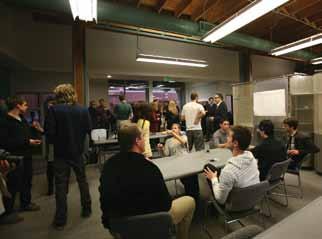
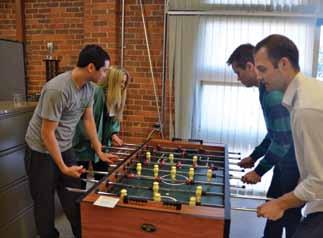
Participants in an improptu “meet-up” share project ideas and strategies
A lone entrepreneur prepares for a meeting in one of the conference rooms

InPress Technologies (a medical device company with a product that prevents post-partum hemorrhaging); and Steadfast Innovation (makers of a mobile app called Papyrus that facilitates better digital hand-written note taking).
After hearing so much glowing praise from business and community members about the SLO HotHouse, we decided to drop by one afternoon, unannounced. The interior of the building has a decidedly urban vibe, as the brick walls provide a visually interesting contrast to the exposed beams and sheet metal ducts. The space feels somewhat like a combination between a coffee shop and a corporate customer service center, complete with the requisite cubicles. Upon entering we were quickly greeted by the two resident staffers, as well as a business consultant, who was serving as a volunteer. Their enthusiasm for the HotHouse and its occupants was palpable and a thorough recap of each team (start-up companies are called “teams” and community members who rent space are called “coworkers”) showed some promising results. In fact, later that day, it was announced that Grappple, a 2012 graduate of the accelerator program, was being acquired by Mountain View-based Whodini Inc. for an undisclosed sum.
We continued to kick the tires for a while and asked if it would be okay to just wander around. Our path through the foosball tables led us to Ian Alexander, who was busy drafting an email in his cube. We learned that Alexander grew up in Berkeley, was a recent Cal Poly grad, and was the leader of team RepairTech. We asked Alexander about his experience so far with the HotHouse; he pondered for a moment and responded by saying, “I like to think that we would have made it without their help, but it seems unlikely.” The company, which is not yet profitable, provides cloudbased diagnostic software to computer repair technicians who pay a monthly fee. With a recent line of credit from a private investor, RepairTech has been able to secure 65 paying accounts and is looking forward to a not-so-far-off time when they all draw salaries and have full-time work. So far, Alexander is the only full-time, non-student team member at RepairTech.
With an estimated operating budget reported to be around $300,000 annually, the HotHouse is required to raise funds beyond what it receives from its revenues, which includes rent from tenants, local donations, and grants. The operation, with the exception of a small bit of funding from the SBA’s Small Business Development Center, which is housed in the facility, is self-funded. For the purpose of raising funds, an innovative campaign was recently launched on indiegogo.com, which is a crowdfunding website where many donors can come together to make pledges as little as $10 to help build a virtual city, which is aptly named “Innovation City.” Local creative agency, iii Design, has posted a video on the site that explains that the HotHouse is seeking to raise $70,000 by June 9th, when their campaign expires (as of this writing they were at $11,050).
The funds will also support the 2013 Summer Accelerator program, which, after a highly competitive application process, seven teams have been accepted including: VegThisWay (makers of a dehydrated vegetable strip healthy snack); SeatWizz (online ticket sellers); PreLimb (software creators for landscape architects to visualize plant growth over time); Spongecrete (developers of a lightweight, insulating concrete composed of cellulose and cement); Before and After Maids (in development of an event clean-up service); Z Living Systems (installers of vertical indoor gardens); and HomeSlice (makers of mobile phone apps for college students and young professionals). As with the previous classes, each of the individual businesses will receive $7,500 grants and assistance from various local mentors. After the twelve-week course ends, the teams will then have the option of continuing their projects into the fall and beyond at the HotHouse. So far, in its short history, the HotHouse’s results have been solid, and it does appear to be universally loved by the students and tenants found there. A couple of the projects have turned into legitimate revenue generating operations, such as RepairTech. Others never became more than overly caffeinated chicken scratches on one of the massive note-filled white boards. But, as is the mantra with venture capital investing: fund 20 early-stage companies that appear to have a chance of making it big and 19 will not amount to much; but the one that does make it, usually makes it huge, often generating returns in the multiples of hundreds of times the original investment, or more. The problem is that, beyond an educated guess, it is nearly impossible to tell which ones the winners will be. And, as is the case with the HotHouse, it really doesn’t matter. What does matter is that students are learning how to be successful in today’s marketplace in a safe and nurturing environment. It’s putting Cal Poly’s “learn by doing” on steroids and making the ultimate beneficiary not the venture capitalists, but the students themselves and, perhaps, the community as a whole.
At the very least, it seems, the HotHouse is a prime example of the tangible results that materialize when Cal Poly and the community join forces to turn a concept into reality. Perhaps the most successful venture to come from the HotHouse so far is the HotHouse itself. Although it remains to be seen what the long-term impact will be for the students; for now, it is encouraging to see the results that come about when we all, um, incubate, together.









Stats: Robbie is a 16-year-old junior at San Luis Obispo High School.
Sports: You can find him mountain biking Shooters or rock climbing at SLO Op.
Clubs: Robbie felt like something was missing, so he re-started the Bike Club on campus.
Interests: Never idle, Robbie spends his free time playing the guitar, piano and singing.

Noteworthy: Music and creativity reign supreme for Robbie and he proved it by composing the incidental and accompaniment for the school play.
Inspiration: Every mom would want to hear what Robbie has to say, “My mother is the largest influence in my life. She’s always supported me, and I’ve always been able to look up to her and how strong she has been through some of the hardest times in life.”
Historical figure he’d like to meet: Robbie fell in love with the music of Ray Charles the first time he heard it. Since then, Charles has been one of the greatest influences in his music and definitely tops the list of who Robbie wishes he could meet, if only he had a time machine.
College aspirations: An AA degree from Cuesta College is first in order for Robbie, followed by a transfer to Berklee College of Music. That said, he wouldn’t pass up the chance to go on tour, or work for a major record label, and plans to keep his options open.
Future prediction: In ten years, Robbie sees himself either on tour as a headlining musician, or working as a music producer inside a studio.
His fondest memory: Making the planter boxes on his driveway with his mom and dad for Pacheco Elementary School.
SLO LIFE
That’s right, the rumors are true!

Dr. Daniel’s orthodontic practice has relocated just around the corner from SLO High School at 1356 Marsh Street.

Although it’s a new address, they are still providing the same excellent care as they have for years.
Since SLO LIFE Magazine was turning three years old, we decided to celebrate by getting ourselves a shiny, new website. We had stuck with the same site from the beginning and, after a few years of studying the analytics and understanding how visitors were using slolifemagazine.com, we felt wellinformed and able to make some smart changes. We learned quite a lot along the way and figured that you and your business may benefit a bit from our experience with the process.

The whole thing started with a visit to our website developer, San Luis Obispo-based ITECH Solutions. Stepping into their offices, as we do from time-to-time, is oddly calming as you would think that their staff of ten would be frantically putting out digital fires in a constant state of panic. But, they’re not, and not much more than whirling computer fans and a symphony of mouse clicks can be detected in their space on El Capitan Way. It looks like a highly professional call center with rows of cubicles, except no one is on the phone. Most of them, it turns out, are either developing websites or remotely monitoring client networks.
We filed into the conference room with notepads full of ideas and requirements for our next website when Forrest Hatfield, ITECH’s co-founder, settled in to his chair to talk things over. This was to be the beginning of the process, an hour-long initial consultation. Hatfield began by asking us what we liked and disliked about our site. While there was nothing entirely wrong with our website, the problem was that we felt that our magazine just didn’t look right online. Up to this point, we had been doing what most other publishers do: create an HTML version of their magazine, which is separate text and photos mainly so that the text is searchable. The benefit of doing it this way is that it encourages “organic search marketing.” For example, if someone goes to Google and searches “Rick Stollmeyer,” the chances are good that our “Meet Your Neighbor” article would pop up high on the results and lead the reader back to our site.
When ITECH Solutions built our first website, they installed a bit of software code called Google Analytics. The program allows us to




log on to find out all types of interesting information about visitors to our site. It tells us how many people visited and from where, whether they were unique visitors or stopped by multiple times. It even shows us what pages they were looking at and how long they stayed. Pretty cool stuff. With Analytics, a free program, we were able to determine that our subscription page was not converting as many leads as it should have been doing. In other words, it appears that people who were interested in buying a subscription would go in, enter their information, get confused or frustrated, and either leave the site or call us on the phone to place their order. Since we are interested in continuing to expand our circulation, we wanted to make it much easier for visitors to buy a subscription on the site and we told Hatfield and his team that improved functionality in this area should be central to the redesign.
When you talk to Hatfield, it is almost as if he is taking your words and breaking them up into little binary bits and bytes, “1’s” and “0’s,” for faster processing. More than just listening, which he seems to do without moving a muscle with eyes wide open, it appears that he is downloading information, and doing it very quickly. Hatfield and his partner, Brian Weiss, co-founded ITECH z web development and Weiss handles IT for the company. The pair, who met at now-defunct Computer Stuff became fast friends and wasted no time in finding a business they could do together. They looked at developing software, but in the end they felt they had the most to offer to companies that were too small to hire their own in-house IT guy or have the funds to hire a big name agency to develop a website. Plus, as Hatfield points out, “When you have one company manage everything there is no finger pointing when things go wrong. We have responsibility for everything, which also makes it better because we know how it all fits together.”
Hatfield loads our current website onto a massive big-screen-TVturned-computer-monitor in the ITECH conference room and patiently hears us out and then makes a request. “Okay, what is it that you want to accomplish with the redesign?” Without hesitation we tell Hatfield and his team that, first and foremost, we are looking to be more user-friendly and take care of visitors in one visit so they do not have to take another step by placing a phone call or sending an email. “Job one,” we tell them, “is the e-commerce aspect of the site—we have to make it easier for people to buy a subscription online.” In addition to wasting a lot of time for everyone involved, mostly, we wanted our subscribers to have a great experience on our site. The room falls silent for a minute as Hatfield meticulously sketches on a sheet of blank office paper. He then spins the drawing around and says, “Here is what I think we ought to do. Mobile is huge right now and getting bigger,
and this is how you can make an impact.”
Hatfield then breaks it down for us. “If you look back to 2010, for example, most of our clients were seeing visits to their websites from mobile devices at about 2% to 3%.” In other words, two or three visits out of 100 to the websites ITECH managed were coming from people who were doing so from their smart phones or tablets. “Today,” Hatfield continues, “depending on the site, it’s as much as 30%.” It was imperative that, whatever we did, the website was conducive to mobile devices. He then shares another trend that ITECH had identified: Google AdWords were becoming more expensive while also becoming less effective and they are witnessing first-hand that many of their clients are returning to traditional media. After sharing the latest trends and strategies in website marketing, Hatfield then goes on to explain the differences between responsive and reactive design and how both, in different ways, would make browsing our site on a smart phone fast, efficient, and much more intuitive for future subscribers. He explained further that a new open source platform made by Twitter called Bootstrap would be an ideal candidate to serve as the backbone for the redesign. “Sounds good,” we say. “Happy birthday to us—let’s do it!”
Since we are also in the business of visual communications, it has always been interesting to follow trends in website design and GUI (graphical user interface) presentation. The late 1990’s brought about the ascendency of “Web 2.0,” which was the movement away from the busy, information-packed, mostly read-only websites to a presentation that was much cleaner and user-focused and, most importantly, included a host of interactive features. Social media was borne out of Web 2.0 and the principles of the design revolution endure today. After Hatfield encouraged us to spend time surfing the web to get design ideas, we then chose our favorites and a sent the links to ITECH along with notes about what we liked about each site.
A couple of weeks later we reconvened in the ITECH conference room. The lights were turned off at the same time the big monitor came to life. On the screen was our new home page looking back at us. Instantly, we knew that they nailed it. The presentation was clean, professional, yet unassuming just as we had asked. And, there was a big red button on the upper right-hand corner that simply said, “Subscribe.” As they navigated through the site, which was not yet live, it became apparent to us how much we had learned over the last three years about how our visitors experienced slolifemagazine.com. And, together with our friends at ITECH, we felt confident that the birthday present we had given ourselves was also for everyone who would stop by our little corner of the world wide web.
“Mobile is huge right now and getting bigger, and this is how you can make an impact.”




It’s hard to make plans for the evening in downtown San Luis Obispo without factoring in food. Even with so many options—ranging from Greek/Mexican blends to gourmet burgers, from sushi to tasty California cuisine—as a local, it is easy to find that you have memorized all the menus and have settled into your favorite restaurants and dishes.
When it comes to my marriage and the Thursday date night my husband and I religiously practice, I’m always trying to follow a bit of advice that was shared with

me not so long ago, “Keep your relationship fresh and exciting. Beware of the mundane and routine when it comes to romance.” In the spirit of doing things differently, we’ve recently adopted a new twist for our night on the town.
Have you ever been to a progressive dinner party? It is a party with several hosts, each one serving a course in their home, where the guests progress from house to house—hence, the name. Essentially it is a potluck dinner, but instead of the food traveling to one location,
the guests travel to the location of the food. It is a great way to mix things up and make dinner more interesting.
Inspired by the progressive dinner party, I applied it to our Thursday date night. Instead of going back and forth with what type of food we were in the mood for, I had us each pick a favorite restaurant and limit our order at each venue to drinks and an appetizer. For less than $100 our bellies were full and our restaurant experience overflowing.

‘‘ Keep your relationship fresh and exciting. Beware of the mundane and routine when it comes to romance.
We indulged in the amazing brussel sprout appetizer ($9 - $22) and a pint from Sidecar’s wide selection of beers ($5 - $8).






It’s easier to keep a workout routine going when you have the support of a friend. And you’re more likely to keep the commitment if you don’t want to disappoint your BFF.
Lay out your clothes the night before your morning routine to help you rise and shine with success. If you hit the gym after work, pack your bag and have it with you, so you can stop o and get t before you get home. Landing at the homestead pre-gym is a motivation killer—you’re more likely to slip on your PJs than your running shoes.
A better indicator of a successful exercise routine is when your clothes t properly, you can lift heavier weights, and workout longer without getting exhausted.

A good night’s sleep will help give you the energy you need to keep up the routine and help you to think more clearly. Once you’re in the cycle of hitting the gym sleep shouldn’t be a problem; studies show that people who exercise four days a week report improved sleep quality, longer sleep, and taking less time to fall asleep.
Once you’ve decided where you are headed it’s a lot easier to plot the course of action to get there. Set a specific, attainable goal like training for a 5k or increasing your number of push-ups.
Most people find that a workout first thing in the morning fits a busy schedule best. If the thought of a 6am workout makes you want to hit the snooze button, try incorporating a walk into your lunch routine or stop off at the gym on your way home from work.


need to guzzle. And watch out for

of sports



It’s best to stick with water unless you are maxing yourself out with a high intensity workout and need the extra electrolytes.


Nothing says summer like grilling burgers. And, here at SLO LIFE Magazine we’ve taken the liberty of revamping the All-American classic with a tangy twist and paired it with delicious baked sweet potato fries.

Hamburgers? Yes. But basic fare? Definitely not! These blue cheese burgers always get a warm reception for their creamy and spicy profile. Use a fine, piquant blue cheese that will stand out; something creamy, but with an almost nefarious amount of veining such as Stilton, Valdeon, or Cabrales. The biggest cloves of garlic you can find are a must, as is a smashing Dijon or homemade mustard.
2 pounds organic grass-fed ground beef
2 tablespoons of Dijon or homemade mustard
2 cloves garlic, minced
4 green onions, finely diced or processed
4 ounces crumbled blue cheese (about 1 cup)
2 egg yolks
2 tablespoons water fresh cracked pepper to taste sea salt to taste
1. Combine all the ingredients together in a bowl until well-mixed. Form eight balls of the meat into patties about 1/2 to 1-inch thick and allow to rest in the fridge for about 15 minutes. While the meat rests, grease and heat the grill to medium-high.
2. Grill the burgers about 5 minutes on each side, or to taste. After the burgers are done allow them to rest for about 1-2 minutes. Serve on buns and garnish as desired.
*Try these tasty burgers served on a roll of your choice such as a Kaiser, brioche, or sourdough along with arugula, sliced tomato and purple onion. And, if you like your burgers spicy, try hot buffalo sauce for garnish.
While you can’t beat the flavor of a perfectly crisp French fry, you certainly could live without the grease-filled fryer they are cooked in and the blood sugar spiking properties of white starchy potatoes. We’ve made these doubly healthy by baking, not frying them, and by using insulin-friendly sweet potatoes.
2-3 sweet potatoes or yams, sliced to ¼ inch thick fry shapes

3 tablespoons coconut oil, melted ½ teaspoon cumin ½ teaspoon oregano ½ teaspoon coriander
1 teaspoon sea salt
1 teaspoon parsley fresh ground pepper to taste
1. Preheat oven to 400°.
2. In a small mixing bowl, add the melted oil and spices. Wisk until combined.
3. In a large mixing bowl, add sliced sweet potatoes and drizzle with spiced coconut oil. Toss until potatoes are coated.
4. Evenly spread potatoes on cookie sheet and bake 30-40 minutes, turning halfway through cooking time.
Sweet potatoes have a lower glycemic index than other spuds, which helps soften their impact on your blood sugar. And research shows that their high carotenoid content may be particularly useful in the blood sugar battle when it comes to managing diabetes.

Have a recipe to share? Go to slolifemagazine.com to tell us about it.


Blue’s Baseball
May 24 - July 31
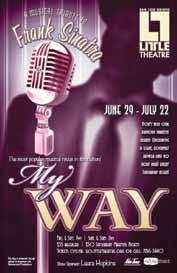
Sinsheimer Stadium bluesbaseball.com
Since 1946, Blue’s Baseball has been a tradition of San Luis Obispo. This family-friendly setting offers plenty of games and activities for the kids, as well as a concession stand and beer truck. Come out and enjoy the game! Hometown fireworks shows will begin immediately following the games on July 3 and July 26.

Roll Out The Barrels
June 20 - 23 San Luis Obispo County slowine.com



The weekend kicks off on Thursday with the annual Barrels in the Mission Plaza event. Friday night features exclusive winemaker dinners at participating wineries and your weekend Passport to SLO Wine Country will grant you entry into over 30 wineries on both Saturday and Sunday.

SLO Little Theatre slolittletheatre.org
Don’t miss the most popular musical revue in the nation, Frank Sinatra! He’s the icon of cool—from classic elegance to contemporary “fedora” hipster. Four accomplished vocalists will take you from the 1940’s Swing Era, to the bright lights of Las Vegas with the Rat Pack in the 1960’s, and to his final performances in the 1990’s. Sinatra’s voice is pop music history. Come hear the songs that his voice made famous.


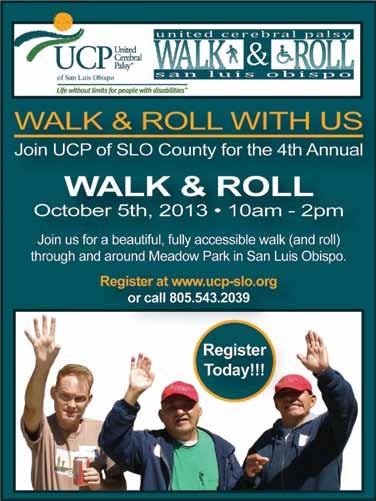
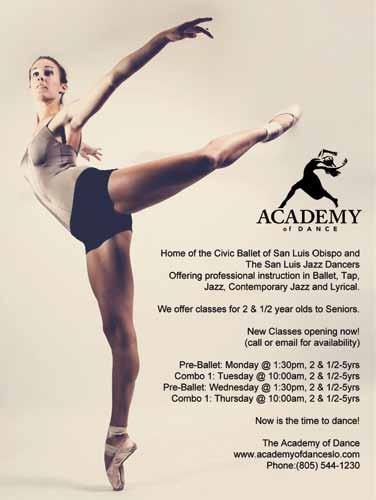
Festival Mozaic July 16 - 28

San Luis Obispo County festivalmozaic.com
The 43rd season of Festival Mozaic features spectacular music in spectacular settings throughout the Central Coast. The Festival is led by Music Director and virtuoso violinist, Scott Yoo, and features players from the St. Paul Chamber Orchestra, the Cleveland Orchestra, the Los Angeles Philharmonic, the Baltimore Symphony and a host of fine orchestras from across the country.
SLO Triathlon July 28 Sinsheimer Park slocity.org
Join in on the fun at the 34th Annual SLO Triathlon. This short course triathlon consists of a 0.5 mile swim, a 15 mile bike, and a 3.1 mile run. Participants will be sent out on the course in waves throughout the day.

Central Coast Shakespeare Festival July 12 - 28







River Oaks Hot Springs & Spa centralcoastshakespeare.org
The 2013 Central Coast Shakespeare Festival will present what is now considered one of Shakespeare’s greatest comedies—Love’s Labour’s Lost. Grab low back chairs, blankets, family and friends, pack a picnic and enjoy live theatre under the stars. Wine will be provided by the Highway 46 East Wineries. Shows start at 7:30 pm on Thursdays, Fridays and Saturdays, and 6:00 pm on Sundays.
